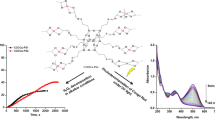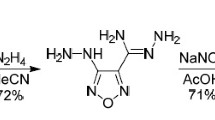Abstract
We present and discuss results on the thermal behaviour of 1,2,3,4,5,6,7,8-octahydroacridine (OHA), together with six 9-substituted congeners, i.e. R = –Br, –OCH3, –NH2, –NO2, –OH, and furyl (–C4H3O), and their corresponding N(10)-oxides, under nitrogen atmosphere and with alumina as reference, at a heating rate of 5 °C min−1 from room temperature to 300 °C. Chromatography has been carried out on aluminium sheets, with aluminium oxide 60 F254 neutral (Merck). Melting effects are observed for almost all compounds in their corresponding curves, precisely determined by using a Boetius apparatus. Homolysis of the carbon-substituent bond occurs in most cases, a phenomenon which is consistent with the values of the bond dissociation energy. For all compounds, except for hydroxyl congeners, thermal decomposition started with an endothermic peak. Octahydroacridines readily decompose into volatile products, an effect which correlates with their low melting points, while little amounts of residue remain in place of the aromatic amines compared to the N(10)-oxides. The presence of N–O bonds greatly influences the thermal stability of the compound, in the sense of increasing it compared with the parent amine. Quantitative studies of the decomposition products reveal that the melting points, the 9-position substituent, and N–O bond all play an important role upon the thermal behaviour. Mechanistic/kinetic pathways are also proposed as such results are important in further designing laser processing protocols, i.e. matrix-assisted pulsed laser evaporation (MAPLE) or laser-induced forward transfer (LIFT), for thin film deposition and/or device printing.





Similar content being viewed by others
References
Adrien A. “The acridines: their preparation, physical, chemical, and biological properties and uses”. London: Eward Arnold & Co; 1951.
Acheson RM. Chemistry of heterocyclic compounds: acridines. 2nd ed. New York: Wiley; 1973. ISBN 0-471-37753-8.
Popp FD. Polyphosphoric acid in the bernthsen reaction. J Org Chem. 1962;27:2658–9. doi:10.1021/jo01054a518.
Rogness DC, Larock RC. Synthesis of acridines by the [4 + 2] annulation of arynes and 2-aminoaryl ketones. J Org Chem. 2010;75:2289–95. doi:10.1021/jo1000687.
Guo HM, Mao RZ, Wang QT, Niu HY, Xie MS, Qu GR. Pd(II)-catalyzed one-pot, three-step route for the synthesis of unsymmetrical acridines. Org Lett. 2013;15:5460–3. doi:10.1021/ol402596g.
Su Q, Li P, He M, Wu Q, Ye L, Mu Y. Facile synthesis of acridine derivatives by ZnCl2-promoted intramolecular cyclization of o-arylaminophenyl schiff bases. Org Lett. 2014;16:18–21. doi:10.1021/ol402732n.
Tanasescu I. Preparation of acridones (and 10-hydroxyacridones) from o-nitrobenzaldehyde and a halobenzene in the presence of concentrated sulfuric acid containing nitrous acid as catalyst. Bull Soc Chim Fr. 1927;41:528.
Lehmstedt K. Eine einfache synthese des acridons und 3-substituierter acridone (IX. Mitteil. über Acridin). Ber Dtsch Chem Ges. 1932;65:834–9. doi:10.1002/cber.19320650531.
Nalwa HS. “Organic materials for third-order nonlinear optics”. Adv Mater. 1993;5:341–58. doi:10.1002/adma.19930050504.
Molinos-Gomez A, Vidal X, Maymo M, Velasco D, Martorell J, Lopez-Calahorra F. Tautomeric enhancement of the hyperpolarizability in new acridine-benzothiazolylamine based NLO chromophores. Tetrahedron. 2005;61:9075–81. doi:10.1016/j.tet.2005.07.045.
Avci D, Comert H, Atalay Y. Ab initio Hartree-Fock calculations on linear and second-order nonlinear optical properties of new acridine-benzothiazolylamine chromophores. J Mol Model. 2008;14:161–9. doi:10.1007/s00894-007-0258-8.
Masamune T. The ultraviolet absorption spectra of stereoisomeric 1,2,3,4,9,10,4a,91-octahydroacridines and related compounds. J Am Chem Soc. 1957;79:4418–23. doi:10.1021/ja01573a048.
Ion V, Matei A, Constantinescu C, Ionita I, Marinescu M, Dinescu M, Emandi A. Octahydroacridine thin films grown by matrix-assisted pulsed laser evaporation for non-linear optical applications. Mater Sci Semicond Process. 2015;36:78–83. doi:10.1016/j.mssp.2015.02.064.
Marinescu M, Tablet C, Potmischil F, Hillebrand M. Experimental and theoretical study of the interaction of 3-carboxy-5,6-benzocoumarin with some 1,2,3,4,5,6,7,8-octahydroacridines and the corresponding N-oxides. Spectrochim Acta A. 2011;81:560–9. doi:10.1016/j.saa.2011.06.051.
Potmischil F, Marinescu M, Loloiu T. Hydroacridines: XXVIII. Syntheses of new 9-substituted 1,2,3,4,5,6,7,8-octahydroacridine derivatives and their N(10)-oxides. Rev Chim. 2007;58:795–8.
Potmischil F, Marinescu M, Nicolescu A, Deleanu C, Hillebrand M. Hydroacridines: part 29. 15N NMR chemical shifts of 9-substituted 1,2,3,4,5,6,7,8-octahydroacridines and their N-oxides—Taft, Swain–Lupton, and other types of linear correlations. Magn Reson Chem. 2008;46:1141–7. doi:10.1002/mrc.2335.
Potmischil F, Marinescu M, Nicolescu A, Deleanu C. Hydroacridines: part 30. 1H and 13C NMR spectra of 9-substituted 1,2,3,4,5,6,7,8-octahydroacridines and of their N-oxides. Magn Reson Chem. 2009;47:1031–5. doi:10.1002/mrc.2507.
Hegde V, Madhukar P, Madura JD, Thummel RP. Fischer route to pyrido [3,2-g] indoles. A novel receptor for urea derivatives. J Am Chem Soc. 1990;112:4549–50. doi:10.1021/ja00167a066.
Hegde V, Hung CY, Madhukar P, Cunningham R, Höpfner T, Thummel RP. Design of receptors for urea derivatives based on the pyrido [3,2-g] indole subunit. J Am Chem Soc. 1993;115:872–8. doi:10.1021/ja00056a008.
Kneeland DM, Ariga K, Lynch VM, Huang CY, Anslyn EV. Bis(alkylguanidinium) receptors for phosphodiesters: effect of counterions, solvent mixtures, and cavity flexibility on complexation. J Am Chem Soc. 1993;115:10042–55. doi:10.1021/ja00075a021.
Kelly-Rowley AM, Lynch VM, Anslyn EV. Molecular recognition of enolates of active methylene compounds in acetonitrile. The interplay between complementarity and basicity and the use of hydrogen bonding to lower guest pKas. J Am Chem Soc. 1995;117:3438–47. doi:10.1021/ja00117a013.
Bell TW, Hou Z, Zimmerman SC, Thiessen PA. Highly effective hydrogen-bonding receptors for guanine derivatives. Angew Chem Int Ed. 1995;34:2163–5. doi:10.1002/anie.199521631.
Bell TW, Hext NM, Khasanov AB. Binding biomolecules with designed, hydrogen-bonding receptors. Pure Appl Chem. 1998;70:2371–7. doi:10.1351/pac199870122371.
Bell TW, Cragg PJ, Drew MGB, Firestone A, Kwok ADI, Liu J, Ludwig RT, Papoulis AT. Synthesis of new torands and new uses for old torands. Pure Appl Chem. 1993;65:361–6. doi:10.1351/pac199365030361.
Bejan E, Fontenas C, Haddou HA, Daran JC, Balavoine GGA. Synthesis of highly soluble annelated polypyridines. Eur J Org Chem. 1999;10:2485–90. doi:10.1002/(SICI)1099-0690(199910)1999:10<2485:AID-EJOC2485>3.0.CO;2-8.
Thummel RP, Jahng Y. Polyaza cavity shaped molecules. 4. Annelated derivatives of 2,2′:6′,2″-terpyridine. J Org Chem. 1985;50:2407–12. doi:10.1021/jo00214a001.
Thummel RP. The application of friedländer and fischer methodologies to the synthesis of organized polyaza cavities. Synlett. 1992;1992:1–12. doi:10.1055/s-1992-21249.
Taffarel E, Chirayil S, Thummel RP. Synthesis and properties of ligands based on benzo[g]quinolone. J Org Chem. 1994;59:823–8. doi:10.1021/jo00083a024.
Keuper R, Risch N. Facile synthesis of polycyclic pyridines, bipyridines, and oligopyridines. Liebigs Annalen. 1996;1996:717–23. doi:10.1002/jlac.199619960512.
Jona E, Lajdova L, Kvasnicova L, Lendvayova S, Pajtasova M, Ondrusova D, Lizak P, Mojumdar SC. Thermal properties of solid complexes with biologically important heterocyclic ligands. Part III. Thermal decomposition and infrared spectra of thiocyanato Mg(II) complexes with 2-hydroxypyridine, quinoline and quinoxaline. J Therm Anal Calorim. 2011;104:817–21. doi:10.1007/s10973-011-1310-6.
Jona E, Lajdova L, Loduhova M, Lendvayova S, Pavlik V, Moncol J, Lizak P, Mojumdar SC. Thermal properties of solid complexes with biologically important heterocyclic ligands. Part IV. Thermal and spectra properties of 2-chloro- and 2-bromobenzoato Cu(II) complexes with nicotinamide and different bonded water molecules. J Therm Anal Calorim. 2012;108:921–6. doi:10.1007/s10973-012-2365-8.
Harmatova Z, Jona E, Medvecka J, Valigura D, Mojumdar SC. Thermal properties of solid complexes with biologically important heterocyclic ligands. J Therm Anal Calorim. 2015;119:915–9. doi:10.1007/s10973-014-4114-7.
Zheng W, Xu W, Wang Y, Chen Z. The theoretical assessment and prediction of C–Br bond dissociation enthalpies. Comput Theor Chem. 1027;2014:116–24. doi:10.1016/j.comptc.2013.11.012.
Baciocchi E. Side-chain reactivity of aromatic radical cations. Acta Chem Scand. 1990;44:645–52. doi:10.3891/acta.chem.scand.44-0645.
Marinescu M, Zalaru C, Florea M, Ionita P. Thermal behavior of several stable hydrazyl free radicals and of their parent hydrazines. J Therm Anal Calorim. 2014;116:259–63. doi:10.1007/s10973-013-3448-x.
Zhu C, Rui L, Fu Y. Homolytic bond dissociation enthalpies of C–C and C–H bonds in highly crowded alkanes. Chin J Chem. 2008;26:1493–500. doi:10.1002/cjoc.200890270.
Acree WE, Pilcher G, Ribeiro da Silva MDMC. The dissociation enthalpies of terminal (N–O) bonds in organic compounds. J Phys Chem Ref Data. 2005;34:553–72. doi:10.1063/1.1851531.
Łukomska M, Rybarczyk-Pirek AJ, Jabłoński M, Palusiak M. The nature of NO-bonding in N-oxide group. Phys Chem Chem Phys. 2015;17:16375–87. doi:10.1039/C5CP02148K.
Sheraz MA, Kazi SH, Ahmed S, Anwar Z, Ahmad I. Photo, thermal and chemical degradation of riboflavin. Beilstein J Org Chem. 2014;10:1999–2012. doi:10.3762/bjoc.10.208.
Razaczynska Z, Danczowska-Burdon A, Sienkiewicz-Gromiuk J. Thermal and spectroscopic properties of light lanthanides (III) and sodium complexes of 2,5-pyridinedicarboxylic acid. J Therm Anal Calorim. 2010;101:671–7. doi:10.1007/s10973-010-0941-3.
Juhász M, Kitahara Y, Takahashi S, Fujii T. Study of the thermal stability properties of pyridoxine using thermogravimetric analysis. Anal Lett. 2012;45:1519–25. doi:10.1080/00032719.2012.675491.
Lippert T. Chapter 7: “UV laser ablation of polymers: from structuring to thin film deposition”. In: Miotello A, Ossi PM, editors. “Laser-surface interactions for new materials production”. Springer, Berlin; 2010. p. 141–175. ISBN: 978-3-642-03306-3 (Print) 978-3-642-03307-0 (Online). doi: 10.1007/978-3-642-03307-0_7.
Fardel R, Nagel M, Nüesch F, Lippert T, Wokaun A, Luk’yanchuk B. “Infuence of thermal diffusion on the laser ablation of thin polymer films”. Appl Phys A Mater Sci Process. 2008;90(4):661–7. doi:10.1007/s00339-007-4334-9.
Rapp L, Constantinescu C, Delaporte P, Alloncle AP. Laser-induced forward transfer of polythiophene-based derivatives for fully polymeric thin film transistors. Org Electron. 2014;15:1868–75. doi:10.1016/j.orgel.2014.04.029.
Constantinescu C, Rapp L, Rotaru P, Delaporte P, Alloncle AP. Pulsed laser processing of poly(3,3‴-didodecyl quarter thiophene) semiconductor for organic thin film transistors. Chem Phys. 2015;450–451:32–8. doi:10.1016/j.chemphys.2015.02.004.
Constantinescu C, Rotaru A, Nedelcea A, Dinescu M. Thermal behavior and matrix-assisted pulsed laser evaporation deposition of functional polymeric materials thin films with potential use in optoelectronics. Mater Sci Semicond Process. 2015;30:242–9. doi:10.1016/j.mssp.2014.10.011.
Constantinescu C, Vizireanu S, Ion V, Aldica G, Stoica SD, Lazea-Stoyanova A, Alloncle AP, Delaporte P, Dinescu G. Laser-induced forward transfer of carbon nanowalls for soft electrodes fabrication. Appl Surf Sci. 2016;. doi:10.1016/j.apsusc.2015.09.089.
Constantinescu C, Rapp L, Rotaru P, Delaporte P, Alloncle AP. Polyvinylphenol (PVP) microcapacitors printed by laser-induced forward transfer (LIFT): multilayered pixel design and thermal analysis investigations. J Phys D Appl Phys. 2016;49:155301. doi:10.1088/0022-3727/49/15/155301.
Zweifel GS, Nantz MH. Modern organic synthesis: an introduction. 1st ed. New York: W.H. Freeman and Co.; 2007. ISBN 978-0-716-77266-8.
Nicolaou KC, Snyder SA, Montagnon T, Vassilikogiannakis G. The Diels–Alder reaction in total synthesis. Angew Chem Int Ed. 2002;41:1668–98. doi:10.1002/1521-3773(20020517)41:10<1668:AID-ANIE1668>3.0.CO;2-Z.
Das A, Maher JP, McCleverty JA, Navas Badiola JA, Ward MD. Metal–metal interactions across symmetrical bipyridyl bridging ligands in binuclear seventeen-electron molybdenum complexes. J Chem Soc Dalton Trans. 1993;681–686. doi: 10.1039/DT9930000681.
Sakurai A, Midorikawa H. The cyclization of ethyl acetoacetate and ketones by ammonium acetate. Bull Chem Soc Japan. 1968;41:165–7. doi:10.1246/bcsj.41.165.
Katritzky AR, Nichols DA, Siskin M, Murugan R, Balasubramanian M. Reactions in high-temperature aqueous media. Chem Rev. 2001;101:837–92. doi:10.1021/cr960103t.
Luches A, Piqué A, Zhigilei LV, editors. Special issue on “Matrix-assisted pulsed laser evaporation: fundamentals and applications”. Appl Phys A. 2011;105:517–671. ISSN: 0947-8396 (Print)/1432-0630 (Online).
Nagel M, Lippert T. Chapter 5.4: Laser-induced forward transfer for the fabrication of devices. In: Singh SC, Zeng H, Guo C, Cai W, editors. Nanomaterials. Processing and characterization with lasers. Weinheim: Wiley; 2012. doi:10.1002/9783527646821.ch5. ISBN 978-3-527-32715-7.
Shaw-Stewart J, Lippert T, Nagel M, Nüesch F, Wokaun A. A simple model for flyer velocity from laser-induced forward transfer with a dynamic release layer. Appl Surf Sci. 2012;258:9309–13. doi:10.1016/j.apsusc.2011.08.111.
Constantinescu C, Morintale E, Ion V, Moldovan A, Luculescu C, Dinescu M, Rotaru P. Thermal, morphological and optical investigations of Cu(DAB)2 thin films produced by matrix-assisted pulsed laser evaporation and laser-induced forward transfer for sensor development. Thin Solid Films. 2012;520:3904–9. doi:10.1016/j.tsf.2012.01.039.
Tabetah M, Matei A, Constantinescu C, Mortensen NP, Dinescu M, Schou J, Zhigilei LV. The minimum amount of ‘matrix’ needed for matrix-assisted pulsed laser deposition of biomolecules. J Phys Chem B. 2014;118:13290–9. doi:10.1021/jp508284n.
Author information
Authors and Affiliations
Corresponding authors
Rights and permissions
About this article
Cite this article
Marinescu, M., Potmischil, F., Florea, M. et al. Thermal behaviour of sym-octahydroacridines and their corresponding N(10)-oxides. J Therm Anal Calorim 131, 117–125 (2018). https://doi.org/10.1007/s10973-016-5862-3
Received:
Accepted:
Published:
Issue Date:
DOI: https://doi.org/10.1007/s10973-016-5862-3




